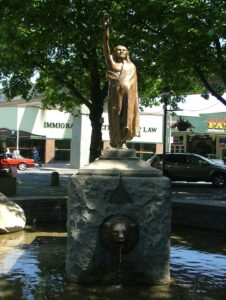It’s easy to miss even if you drive right by. I’m referring to the statue of Chief Seattle with his raised outstretched hand installed under a clump of trees along Denny Way on the northern downtown edge of the city named for him.
The monument by local sculptor James Wehn will have its 100th birthday on November 13. That’s also the 161st anniversary of the big day in 1851 when a group of gringos from Illinois (including the Dennys for whom Denny Way is named) showed up on Alki Point jutting out into Puget Sound and started the process of clearing out all the native Americans. In Seattle November 13 is now called Founders Day, ignoring the presence since time immemorial of the original locals.
The Chief Seattle statue is now dwarfed by nearby skyscrapers, including the Space Needle, and there is scant evidence anymore around Seattle of indigenous culture. Which is not surprising. The fate of Seattle-area Indians is pretty much the same story played out all around the country. Early promises of friendship followed by take-it-or-else offers to move off the good land conducive to farming and fishing and shipping. Followed by bloodshed, often at the hands of U.S. military forces called in by gringos fancying themselves rugged individuals to eliminate the natives.
What makes the story of Chief Seattle so unusual is that he made the best of a losing hand and avoided the bloodshed part. Immediately realizing he eventually would be outnumbered–and outgunned–by the gringos, he decided to deal with them. The fact that he was facing threats from rival Indian tribes probably was a factor, too. Chief Seattle’s early friendship with the gringos is the major reason why after just two years the rapidly growing town on the eastern edge of Puget Sound took his name. At his death in 1866 in his early 80s, he was probably the most respected figure in the newly formed Washington Territory–especially, and amazingly, among the gringos.
Seattle was born in the mid-1780s. Decades later, he said he watched as a boy in 1792 when British Navy captain George Vancouver led the first European expedition to set eyes upon the area he named for his lieutenant, Peter Puget. Son of a chief and surprisingly tall, Seattle became a leader himself of the Duwamish tribe, distinguishing himself in battle against other Indian tribes throughout the region (and taking slaves in the process). He also acquired a reputation as an orator. In other words, he had the skills of a fine politician. Seattle also traded goods with the Hudson Bay Co. outpost near Olympia, farther south along the Sound, giving him early experience in dealing with whites.
After striking up a friendship at age 65 or so with the early gringo settlers and bargaining for rights while ceding land, Chief Seattle kept his warriors out of the one-day Battle of Seattle. That was an 1856 skirmish between attacking Indian tribes and the U.S. Navy that was part of the two-year-long Puget Sound War to make the areas safe for gringos. The Battle of Seattle is probably best known today because the territorial authorities later convicted of murder and hanged Nisqually tribe Chief Leschi even though wartime killing of combatants then and now was not a crime. The execution was considered such a miscarriage of justice even then that a Seattle neighborhood which still stands was soon named for Leschi.
Part of the present-day mystique surrounding Chief Seattle stems from a haunting speech he supposedly gave in 1854 or 1855 to a gathering of gringos in his namesake city in which he foresaw the elimination of Indians: “When the last Red Man shall have perished, and the memory of my tribe shall have become a myth among the white man, these shores will swarm with the invisible dead of my tribe, and when your children’s children think themselves alone in the field, the store, the shop, or in the silence of the pathless woods, they will not be alone.”
Nice thoughts. But historians generally agree today there is no evidence Chief Seattle spoke those words. The alleged speech wasn’t even published until 1887.
But thanks to contemporary newspaper accounts we know some of the words that Edmond S. Meany, a University of Washington professor, spoke to a crowd of hundreds at the statue dedication a century ago on Founders Day. “Here was a man who was tutored by the the forest and the ocean, by the wolf and the eagle, a child of the wilderness,” Meany said. “And yet he has left us a priceless legacy of loyalty, truth and courage.”
Chief Seattle’s outstretched hand on the statue was supposedly to symbolize his greeting the Denny Party as it approached Alki Point. But in my view, he really was saying goodbye to his land.


Pingback: In blasting Pete Carroll, Seattle forgets it grew through similar risk-taking - New To Seattle
Pingback: Seattle ducks racial blame again by nixing Columbus Day - New To Seattle
Pingback: Looming spotlight: Seattle suburb vote on $15 minimum wage | New To Seattle
Pingback: Monumental Seattle (Part 3) | New To Seattle
Pingback: Folks in Seattle don’t dress for the rain | New To Seattle
Pingback: Monumental Seattle (Part 2) | New To Seattle
Pingback: Seattle media go nuts over prediction of minimal rain | New To Seattle
Pingback: Wordless Wednesday Chief Seattle | Rear View Mirror The Contemporary Romance Novel